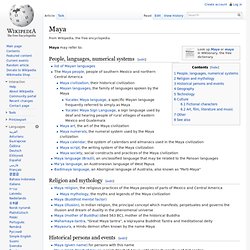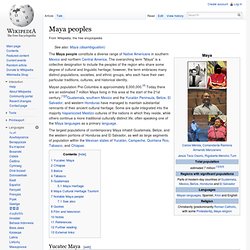

Maya. From Wikipedia, the free encyclopedia Maya may refer to: People, languages, numerical systems[edit] Religion and mythology[edit] Historical persons and events[edit] Geography[edit] Technology[edit] Japanese cruiser Maya of the Imperial Japanese NavyJapanese gunboat Maya, the lead ship of the Maya-class gunboats of the early Imperial Japanese NavyMaya, the NATO reporting name for Aero L-29 Delfín, a Czech military jet trainer aircraftAutodesk Maya, a computer program for creating 3D graphicsWashburn Maya Signature Series, a series of six-string electric guitars created by Washburn Guitars Culture[edit] Fictional characters[edit] Art, film, literature and music[edit] Other[edit] See also[edit]

Maya civilization. Uxmal, Nunnery Quadrangle Artist's copy of Bonampak Painting, Mexico, 700 C.E.

Throne 1 of Piedras Negras The Maya is a Mesoamerican civilization, noted for Maya script, the only known fully developed writing system of the pre-Columbian Americas, as well as for its art, architecture, and mathematical and astronomical systems. Initially established during the Pre-Classic period (c. 2000 BC to AD 250), according to the Mesoamerican chronology, many Maya cities reached their highest state of development during the Classic period (c. AD 250 to 900), and continued throughout the Post-Classic period until the arrival of the Spanish. The Maya civilization shares many features with other Mesoamerican civilizations due to the high degree of interaction and cultural diffusion that characterized the region. The Maya peoples survived the Classic period collapse and the arrival of the Spanish conquistadores and sixteenth-century Spanish colonization of the Americas.
Geographical extent History. Maya peoples. The Maya people constitute a diverse range of Native Americans in southern Mexico and northern Central America.

The overarching term "Maya" is a collective designation to include the peoples of the region who share some degree of cultural and linguistic heritage; however, the term embraces many distinct populations, societies, and ethnic groups, who each have their own particular traditions, cultures, and historical identity. Mayan population Pre-Columbia is approximately 8,000,000.[4] Today there are an estimated 7 million Maya living in this area at the start of the 21st century.[1][2]Guatemala, southern Mexico and the Yucatán Peninsula, Belize, El Salvador, and western Honduras have managed to maintain substantial remnants of their ancient cultural heritage.
Yucatec Maya[edit] A Jade mask from the state of Campeche One of the largest group of modern Maya can be found in Mexico's Yucatán state and the neighboring states of Campeche and Quitana Roo. Chichen Itza Chiapas[edit] Belize[edit] Mesoamerica. Mesoamerica and its cultural areas Mesoamerica is a region and cultural area in the Americas, extending approximately from central Mexico to Belize, Guatemala, El Salvador, Honduras, Nicaragua, and northern Costa Rica, within which a number of pre-Columbian societies flourished before the Spanish colonization of the Americas in the 15th and 16th centuries.[1][2] It is one of six areas in the world where ancient civilization arose independently, and the second in the Americas after Norte Chico (Caral-Supe) in present-day northern coastal Peru.

Among the earliest complex civilizations was the Olmec culture, which inhabited the Gulf coast of Mexico and extended inland and southwards across the Isthmus of Tehuantepec. Frequent contact and cultural interchange between the early Olmec and other cultures in Chiapas, Guatemala and Oaxaca laid the basis for the Mesoamerican cultural area. The distinct Mesoamerican cultural tradition ended with the Spanish conquest in the 16th century.